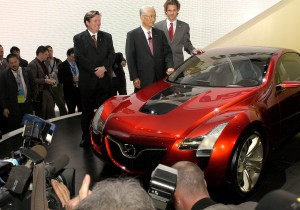The rotary engine is the powertrain of the future – and always will be, declares the engineers who have spent frustrating decades trying to overcome the once-promising Wankel engine’s drawbacks.
Small, light and powerful, the rotary seemed destined for glory, with makers such as General Motors, Mazda and American Motors among the many manufacturers committed to using the engine back in the 1970s. But then the first Mideast energy crisis struck and all but Mazda were forced to abandon the Wankel due to its relatively poor fuel economy.
Over the years, Mazda has scaled back rotary applications but never abandoned the technology – and now, the Japanese maker may have come up with an intriguing solution, using a laser ignition system, instead of conventional spark plugs to boost the Wankel’s fuel efficiency.
The British magazine AutoCar quotes a “senior,” albeit unidentified Mazda engineer involved with the ongoing development of Mazda’s next-generation rotary, known as the 16X Renesis.
The idea is that a high-power laser can generate the temperatures needed in lieu of an electric spark to ignite the air/fuel mixture in the Renesis. In turn, that would permit the new engine to run extremely lean – which translates into significantly better mileage if it can work.
A laser could also be used to more accurately control the timing of the ignition process than a conventional spark ignition system. Lasers can produce incredibly hot pulses that last the smallest fraction of a second – researchers hoping to trigger a controlled fusion process use beams of cohesive light to recreate the incredible heat seen in the core of the sun.
A laser ignition device could prove significantly smaller than the typical spark plug – perhaps a third of an inch wide and half an inch long. It would likely be made of ceramics to survive the harsh environment inside a rotary engine.
Using a laser for the rotary engine “was absolutely possible,” the source told AutoCar.
It might also be critical if the Wankel engine is going to survive in a world of increasingly tough emissions and mileage regulations. Mazda had to pull the RX-8, its last global model using the rotary, out of the European market because it couldn’t meet the latest Continental clean air standards.
Should the concept work, a production version of the 16X Renesis would likely grow from the initial 1.3 liters to 1.6, according to the magazine. But the overall package has shrunk – and it has shed weight by switching to aluminum.
There’s no word on where a new rotary might appear, though a production version of the Mazda Kabura concept might be one possibility as a replacement for the current RX-8.


Along with Mazda, also FEV and AVL are currently investing (or just heavily advertising in the Press) their WANKEL engine Range-Extenders.
Besides the known simplicity, lightweight and package of the WANKEL engine, FEV and AVL are proud of the vibration-free superiority of the Wankel, as compared with the conventional engine.
At http://www.pattakon.com/pattakonPatOP.htm and http://www.pattakon.com/pattakonOPRE.htm Mazda, FEV and AVL can find engines that are more vibration free than the Wankel engine.
With respect to the inertia forces and moments (inertia vibrations), an OPRE engine driving two counter-rotating electric generators is as vibration-free as a Wankel range extender.
But with respect to the combustion-pulses (power vibrations), an OPRE range extender is way more vibration free than any Wankel range extenderl: pure mathematics.
Thanks
Manousos Pattakos